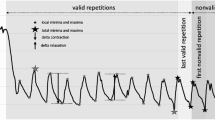Abstract
Ice-climbers frequently use the squeezing of a rubber rings for increasing their isometric strength-endurance in the forearm muscles. The aim of this study was to ascertain whether such training influences oxygenation and endurance of forearm muscles at higher as well as lower testing intensities. Fourteen healthy young ice-climbers were divided and randomized into two groups. Group A performed a specific ice-climbing test, an ice-axe-grasping (axe weight 750 g) until fatigue. Group B performed 150 N isometric hand-squeezing of dynamometer until fatigue. Both groups performed similar training of squeezing a rubber ring at 30% of Maximal Voluntary Contraction (MVC) for 6 weeks. The forearm oxygenation was assessed by relative saturation of oxygen (RSO2), total hemoglobin concentration (RTOTHb), the concentration of oxygenated hemoglobin (ROXYHb) and concentration of deoxygenated hemoglobin (RDEOXYHb). The results revealed that muscle strength-endurance training increased performance of forearm muscles during 150 N contraction with an accompanied increase in oxygenation of the exercising muscles. In contrast, the same training did not influence the performance of forearm muscles during ice-axe-grasping in spite of increased oxygenation. Muscle oxygenation during intense isometric contraction is low in spite of an increase observed in training. This may be due to oxygenation levels that were below the limit where oxygenation may influence the duration of the contraction. Increased oxygenation may have occurred due to an increased blood flow and perfusion through superficial muscles or layers may not have contributed to the generation of the force of the contraction, as would be the case in deeper muscle layers.





Similar content being viewed by others

References
Barcroft H, Greenwood B, Whelan RF (1963) Blood flow and venous oxygen saturation during sustained contraction of the forearm muscle. J Physiol 168:848–856
Barnes WS (1980) The relationship between maximal isometric strength and intramuscular circulatory occlusion. Ergonomics 23:351–357
Boushal R, Pott F, Madsen P, Rodegram G, Nowak M, Quistorf B, Secher N (1998) Muscle metabolism from near infrared spectroscopy during rhytmic handgrip in humans. Eur J Appl Physiol Occup Physiol 79(1):41–48
Bystrom SEG, Kilbom A (1990) Physiological response in the forearm during and after isometric intermittent handgrip. Eur J Appl Physiol 60:457–466
Ferrari M, Mottola L, Quaresima V (2004) Principles, techniques, and limitations of near infrared spectroscopy. Can J Appl Physiol 29(4):463–487
Hicks A, McGill S, Hugson RL (1999) Tissue oxygenation by near-infrared spectroscopy, and muscle blood flow during isometric contractions of the forearm. Can J Appl Physiol 24(3):216–230
Humphreys PW, Lind AR (1963) The blood flow through active and inactive muscles of the forearm during sustained hand-grip contractions. J Physiol 166:120–135
Joiner MJ, Proctor DN (1999) Muscle blood flow during exercise: the limits of reductionism. Med Sci Sports Exerc 31(7):1036–1049
Kalliokoski KK, Laaksonen MS, Takala TO, Knuuti J, Nuutila P (2003) Muscle oxygen extraction and perfusion heterogeneity during continuous and intermittent static exercise. J Appl Physiol 94:953–958
Larsson SE, Zang Q, Larsson R, Coi H, Oberg PA (1996) Single-fibre laser doppler flowmetry and electromiography for evaluating microcirculation in forearm muscle during static and continuous handgrip contractions. Eur J Appl Physiol 73:219–224
Sadamoto T, Bonde-Petersen F, Suzuki Y (1983) Skeletal muscle tension, flow, pressure, and EMG during sustained isometric contractions in humans. Eur J Appl Physiol 51:395–400
Sjogaard G, Savard G, Carsten J (1988) Muscle blood flow during isometric activity and its relation to muscle fatigue. Eur J Appl Physiol 57:327–335
Somers VK, Leo KC, Shiefds R, Clary M, Mark AL (1992) Forearm endurance training attenuates sympathetic nerve response to isometric handgrip in normal humans. J Appl Physiol 72(3):1039–1043
Ušaj A (2001) The endurance training effect on the oxygenation status of an isometrically contracted forearm muscle. Pflugers Arch Eur J Physiol 442(Suppl 1):R155–R156
Ušaj A (2002) Differences in the oxygenation of the forearm muscle during isometric contraction in trained and untrained subjects. Cell Mol Biol Lett 7(2):375–377
Walley KR (1996) Heterogeneity of oxygen delivery impairs oxygen extraction by pheripheral tissue: theory. J Appl Physiol 81(2):885–329
Wilmore JH, Costill DL (1994) Physiology of sport and exercise. Human Kinetics, Champaign, IL, pp 70–71
Yasuda Y, Miyamura M(1983) Cross transfer effects of muscular training on blood flow in the ipsilateral and contralateral forearms. Eur J Appl Physiol 51:321–329
Author information
Authors and Affiliations
Corresponding author
Rights and permissions
About this article
Cite this article
Ušaj, A., Jereb, B., Robi, P. et al. The influence of strength-endurance training on the oxygenation of isometrically contracted forearm muscles. Eur J Appl Physiol 100, 685–692 (2007). https://doi.org/10.1007/s00421-007-0461-4
Accepted:
Published:
Issue Date:
DOI: https://doi.org/10.1007/s00421-007-0461-4



